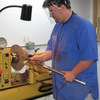As I get more into turning I find that my tools and whatnots far exceed the capacity of the one shelf I currently have over my lathe. I'm thinking about repositioning it perpendicular to the wall instead of against it, but then I lose the ability to have everything right there at eye level. Could y'all offer some tips for how to organize this area of my shop and maybe post some pics? Thanks in advance!




 Reply With Quote
Reply With Quote








